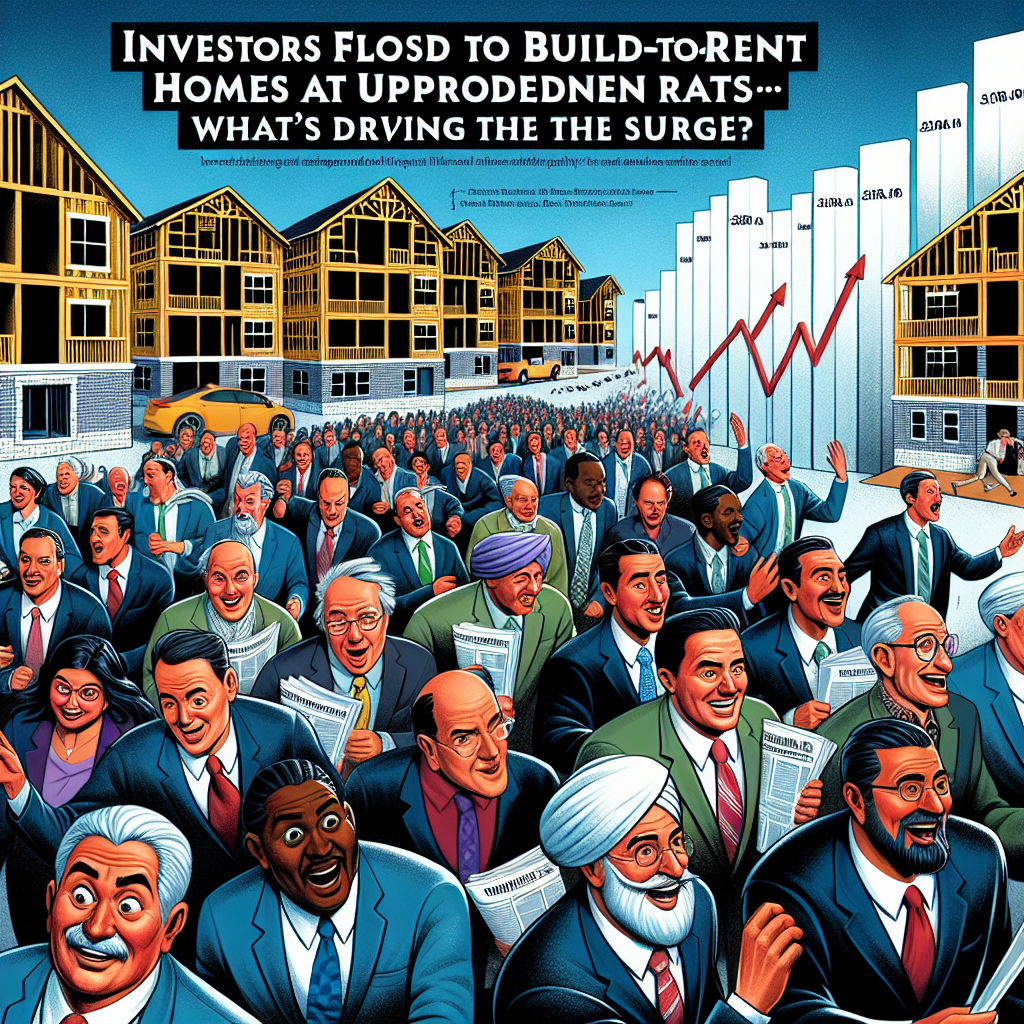-
Table of Contents
- Investors Flock to Build-to-Rent Homes at Unprecedented Rates—What’s Driving the Surge?
- Understanding Build-to-Rent Homes
- The Surge in Build-to-Rent Investments
- Changing Demographics
- Economic Conditions
- Evolving Consumer Preferences
- Case Studies: Successful Build-to-Rent Projects
- Case Study 1: The Collective, London
- Case Study 2: Greystar, United States
- Case Study 3: Mirvac, Australia
- Statistics: The Growth of Build-to-Rent
- Implications for Investors and Renters
- Implications for Investors
- Implications for Renters
- Conclusion
Investors Flock to Build-to-Rent Homes at Unprecedented Rates—What’s Driving the Surge?

The real estate market is experiencing a significant shift as investors increasingly turn their attention to build-to-rent (BTR) homes. This trend, which has been gaining momentum over the past few years, is now reaching unprecedented levels. But what exactly is driving this surge? In this article, we will explore the factors contributing to the rise of BTR homes, examine relevant case studies, and analyze the implications for both investors and renters.
Understanding Build-to-Rent Homes
Build-to-rent homes, also known as BTR or multifamily rental properties, are residential properties specifically constructed for the purpose of renting rather than selling. Unlike traditional rental properties, which are often converted from owner-occupied homes, BTR homes are designed with renters in mind from the outset. This means they often come with amenities and features that cater to the needs and preferences of tenants.
The Surge in Build-to-Rent Investments
Several factors are contributing to the surge in BTR investments. These include changing demographics, economic conditions, and evolving consumer preferences. Let’s delve into each of these factors in more detail.
Changing Demographics
One of the primary drivers of the BTR boom is the changing demographic landscape. Millennials and Generation Z are now the largest cohorts in the rental market, and their preferences are shaping the industry. These younger generations tend to prioritize flexibility and convenience over homeownership, making renting a more attractive option.
- Millennials: Many millennials are delaying homeownership due to factors such as student loan debt, high housing costs, and a desire for mobility. As a result, they are more likely to rent for longer periods.
- Generation Z: The youngest generation in the workforce is also showing a preference for renting. They value experiences over possessions and are less inclined to commit to long-term homeownership.
Economic Conditions
Economic factors are also playing a significant role in the rise of BTR investments. The COVID-19 pandemic has had a profound impact on the economy, leading to increased uncertainty and financial instability for many individuals. This has made renting a more viable option for those who may not have the financial means to purchase a home.
- Affordability: The affordability crisis in many urban areas has made homeownership out of reach for a significant portion of the population. Renting provides a more affordable alternative.
- Job Market: The gig economy and remote work trends have created a more transient workforce. Renting offers the flexibility needed to adapt to changing job locations and circumstances.
Evolving Consumer Preferences
Consumer preferences are also shifting in favor of renting. Today’s renters are looking for more than just a place to live; they want a lifestyle. BTR properties are designed to meet these demands by offering a range of amenities and services that enhance the rental experience.
- Amenities: BTR homes often come with amenities such as fitness centers, co-working spaces, and communal areas that foster a sense of community.
- Maintenance: Renters appreciate the convenience of having maintenance and repairs handled by property management, reducing the burden of homeownership.
- Flexibility: BTR properties offer flexible lease terms, allowing renters to move without the long-term commitment of owning a home.
Case Studies: Successful Build-to-Rent Projects
To better understand the impact of BTR investments, let’s examine a few successful case studies from around the world.
Case Study 1: The Collective, London
The Collective is a pioneering BTR development in London that has redefined urban living. This co-living space offers fully furnished apartments with access to a wide range of amenities, including a gym, cinema, and rooftop terrace. The Collective’s success can be attributed to its focus on community and convenience, attracting young professionals who value a vibrant and connected lifestyle.
Case Study 2: Greystar, United States
Greystar, one of the largest BTR developers in the United States, has successfully implemented BTR projects across the country. Their properties are known for their high-quality construction, modern design, and extensive amenities. Greystar’s ability to adapt to local market conditions and cater to the needs of renters has made them a leader in the BTR sector.
Case Study 3: Mirvac, Australia
Mirvac, an Australian property group, has embraced the BTR model with projects such as LIV Indigo in Sydney. This development offers a range of apartment sizes and layouts, along with amenities like a rooftop garden, pet-friendly spaces, and a dedicated resident app. Mirvac’s focus on sustainability and community engagement has resonated with renters, contributing to the success of their BTR ventures.
Statistics: The Growth of Build-to-Rent
The growth of the BTR sector is evident in the numbers. Here are some key statistics that highlight the rapid expansion of BTR investments:
- United States: According to a report by Yardi Matrix, the BTR sector in the U.S. saw a 22% increase in new projects in 2021, with over 50,000 units under construction.
- United Kingdom: The British Property Federation reported that the number of BTR homes in the UK increased by 30% in 2020, with over 150,000 units in the pipeline.
- Australia: The Property Council of Australia noted that the BTR sector is expected to grow by 70% over the next five years, driven by strong demand from renters.
Implications for Investors and Renters
The surge in BTR investments has significant implications for both investors and renters. Let’s explore how this trend is impacting each group.
Implications for Investors
For investors, the BTR sector offers several advantages:
- Stable Income: BTR properties provide a steady stream of rental income, which can be more predictable than the returns from traditional real estate investments.
- Diversification: Investing in BTR properties allows investors to diversify their portfolios and reduce risk.
- Long-Term Growth: The demand for rental housing is expected to remain strong, providing opportunities for long-term capital appreciation.
However, there are also challenges to consider:
- Regulatory Environment: Investors must navigate complex regulations and zoning laws that can vary by location.
- Market Saturation: As more investors enter the BTR market, competition for prime locations and tenants may increase.
Implications for Renters
For renters, the rise of BTR properties offers several benefits:
- Quality Housing: BTR homes are often built to high standards, providing renters with modern, well-maintained living spaces.
- Amenities: The amenities offered by BTR properties enhance the rental experience and contribute to a higher quality of life.
- Flexibility: Renters can enjoy the flexibility of lease terms that suit their needs, without the long-term commitment of homeownership.
However, there are also potential downsides:
- Cost: The premium amenities and services offered by BTR properties can come at a higher cost compared to traditional rentals.
- Availability: In some markets, the supply of BTR homes may not keep pace with demand, leading to limited availability.
Conclusion
The surge in build-to-rent investments is a testament to the changing dynamics of the real estate market. Driven by shifting demographics, economic conditions, and evolving consumer preferences, BTR properties are becoming an increasingly attractive option for both investors and renters. As the sector continues to grow, it will be essential for stakeholders to navigate the challenges and seize the opportunities presented by this burgeoning market.
In summary, the rise of build-to-rent homes reflects a broader trend towards flexibility, convenience, and community in the housing market. For investors, BTR properties offer stable income and long-term growth potential, while renters benefit from high-quality housing and premium amenities. As the demand for rental housing continues to rise, the build-to-rent sector is poised for continued expansion, reshaping the future of residential real estate.








